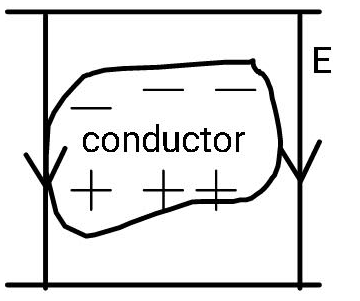
Inside a hollow conducting sphere:
A. electric field is zero
B. electric field is a non zero constant
C. electric field changes with magnitude of the charge given to the conductor
D. electric field changes with distance from the centre of the sphere.
Answer
486.6k+ views
Hint: Electric field is produced due to presence of charges. It is defined as the force acting on a unit charge. Conductors have free electrons that travel on its surface and help in shielding out the electric field.
Complete answer:
If we have a uniform static electric field and we place a test charge in it, the test charge experiences a force on it and moves according to the direction of the electric field. The positive charges tend to move along the direction of the applied electric field and the negative charges tend to move in the direction opposite to the applied electric field.
Suppose if we place a solid conductor in a uniform electric field like below:

We will observe that on the upper surface of the conductor, negative charges appear and on the lower surface of the conductor positive charges appear. A conductor has free electrons that can move around (they do not remain bound to an atom). These electrons tend to redistribute according to the external conditions. In our case we provided an electric field so the electrons felt the attraction and moved to the upper surface, so the lower surface automatically became positively charged due to deficiency of electrons. This creates an opposing electric field inside the conductor which shields out the external electric field.
In the question we are asked about how a hollow conducting sphere would respond to an external electric field. The answer is that it will also redistribute its electrons and shield out the external electric field completely. Therefore, inside the conducting hollow sphere the electric field will be zero. The correct answer is option (A).
So, the correct answer is “Option A”.
Note:
The electric field inside a conductor is zero but the potential inside a conductor is not zero. Therefore if we were asked what would be the potential inside the conductor we would have to do some calculations in that case. The potential inside will be the same as on the surface of the conductor.
Complete answer:
If we have a uniform static electric field and we place a test charge in it, the test charge experiences a force on it and moves according to the direction of the electric field. The positive charges tend to move along the direction of the applied electric field and the negative charges tend to move in the direction opposite to the applied electric field.
Suppose if we place a solid conductor in a uniform electric field like below:

We will observe that on the upper surface of the conductor, negative charges appear and on the lower surface of the conductor positive charges appear. A conductor has free electrons that can move around (they do not remain bound to an atom). These electrons tend to redistribute according to the external conditions. In our case we provided an electric field so the electrons felt the attraction and moved to the upper surface, so the lower surface automatically became positively charged due to deficiency of electrons. This creates an opposing electric field inside the conductor which shields out the external electric field.
In the question we are asked about how a hollow conducting sphere would respond to an external electric field. The answer is that it will also redistribute its electrons and shield out the external electric field completely. Therefore, inside the conducting hollow sphere the electric field will be zero. The correct answer is option (A).
So, the correct answer is “Option A”.
Note:
The electric field inside a conductor is zero but the potential inside a conductor is not zero. Therefore if we were asked what would be the potential inside the conductor we would have to do some calculations in that case. The potential inside will be the same as on the surface of the conductor.
Recently Updated Pages
Master Class 9 General Knowledge: Engaging Questions & Answers for Success

Master Class 9 English: Engaging Questions & Answers for Success

Master Class 9 Science: Engaging Questions & Answers for Success

Master Class 9 Social Science: Engaging Questions & Answers for Success

Master Class 9 Maths: Engaging Questions & Answers for Success

Class 9 Question and Answer - Your Ultimate Solutions Guide

Trending doubts
Types of lever in which effort is in between fulcrum class 12 physics CBSE

Which are the Top 10 Largest Countries of the World?

A two input XOR Gate produces a high output only when class 12 physics CBSE

What is a transformer Explain the principle construction class 12 physics CBSE

Give five points to show the significance of varia class 12 biology CBSE

Draw a labelled sketch of the human eye class 12 physics CBSE




